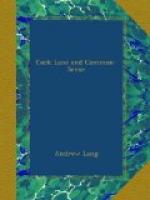The more part of mediaeval witchcraft, therefore, is not quod semper, quod ubique, quod ab omnibus. The facts were facts: people really died or were sterile, flocks suffered, ships were wrecked, fields were ruined; the mistake lay in attributing these things to witchcraft. On the other hand, the facts of rappings, ghosts, clairvoyance, in spite of the universally consentient evidence, are very doubtful facts after all. Their existence has to be established before we look about for their cause. Now, of records about these phenomena the Middle Ages produce but a very scanty supply. The miracles which were so common were seldom of this kind; they were imposing visions of devils, or of angels, or of saints; processions of happy or unhappy souls; views of heaven, hell, or purgatory. The reason is not far to seek: ecclesiastical chroniclers, like classical men of letters, recorded events which interested themselves; a wraith, or common ghost (’matter of daily experience,’ says Lavaterus, and, later, contradicts himself), or knocking sprite, was beneath their notice. In mediaeval sermons we meet a few edifying wraiths and ghosts, returning in obedience to a compact made while in the body. Here and there a chronicle, as of Rudolf of Fulda (858), vouches for communication with a rapping bogle. Grimm has collected several cases under the head of ’House-sprites,’ including this ancient one at Capmunti, near Bingen. {30} Gervase of Tilbury, Marie de France, John Major, Froissart, mention an occasional follet, brownie, or knocking sprite. The prayers of the Church contain a petition against the spiritus percutiens, or spirit who produces ‘percussive noises’. The Norsemen of the Viking age were given to second sight, and Glam ‘riding the roofs,’ made disturbances worthy of a spectre peculiarly able-bodied. But, not counting the evidence of the Icelandic sagas, mediaeval literature, like classical literature, needs to be carefully sifted before it yields a few grains of such facts as sane and educated witnesses even now aver to be matter of their personal experience. No doubt the beliefs were prevalent, the Latin prayer proves that, but examples were seldom recorded.




